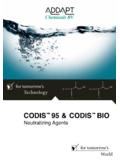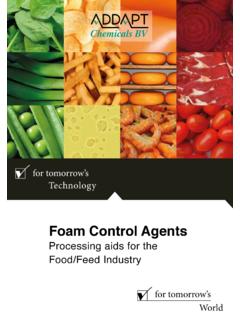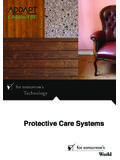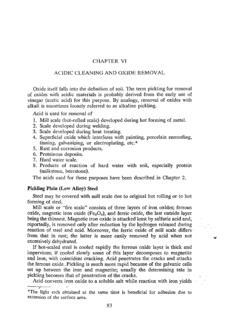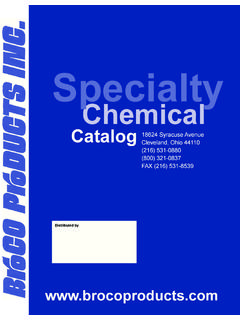Transcription of Phosphate Esters - ADDAPT Chemicals BV
1 PEX Phosphate Estersfor tomorrow sTechnologyfor tomorrow sWo r l dChemicals BVContents1. Introduction 32. Product range 43. Application properties 4 Emulsification - Emulsion Polymerisation 4 Solubilisation and solubility 5 Corrosion inhibition, de-rusting, lime scale removal 6 Metalworking products 7 Textile and Leather; antistatic 8 Agrochemical additives 8 Oil field Chemicals 9 Home Care and I&I 94.
2 Biodegradability/Eco-toxicity 1121. IntroductionPhosphate Esters are 100% active anionic surfactants which are produced as the free acid by either of two chemical routes. Mixtures of mono- and diesters are produced by reaction of either alcohols, alcohol ethoxylates or phenol ethoxylates with phosphorous pentoxide. Phosphate Esters with a high(er) monoester content are produced by the reaction of the same feedstock with poly-phosphoric PEX anionic surfactants are mixtures of mono- and diesters which have the following general formula: Monoester Diester O O || || RO P OH RO P OH | | OH ORWhere R- is derived from an alcohol or ethoxylated alcohol.
3 The ratio mono- and diester is dependent on the method of production (see above).A phosphoric ester is acidic as phosphoric acid and has similar phosphatising properties. The ionic Phosphate functionality imparts antistatic properties to the nature of the R- group is the major factor which determines the additional properties. If this group is an auxiliary surfactant itself, such as an ethoxylate, then the detergency and wetting are greatly improved. If the group is hydrophobic then some degree of de-foaming will occur and oil solubility increased, solubility in water declines and acidity is PEX Phosphate Esters32. Product rangeADDAPT PEX Phosphate Esters are available as the free acid and in most cases as the Potassium, Sodium or Triethanolamine salt. Due to eco-toxicity problems, phenol/phenolethoxylate derived Phosphate Esters are not propertiesSome of the useful properties are: Emulsification Excellent lubrication Solubilisation (hydrotopes) Dispersant Corrosion inhibition Anti-static Surface wetting Detergency 3.
4 Application Emulsification - Emulsion PolymerisationADDAPT PEX Phosphate Esters are versatile emulsifiers. By careful selection of the R-group and neutralising agent, an emulsifier for most industrial systems can be 106(m), PEX 136(m) and PEX 176 are used in emulsion polymerisation to emulsify the monomer and impart stabilisation to the final polymer dispersion. A wide range of ethoxylates can be phosphated allowing greater flexibility to produce polymers with the desired end varying the mono- and diester ratio, it is possible to fine-tune the HLB value to further optimise performance. Starting point formulations are available upon name R- AlcoholsEO (nominal)% PAppearancePEX 010*CH3--26 - 27 %Pale yellow liquidPEX 080B2-EthylHexyl--11 - 12 %Pale yellow liquidPEX 080Bm2-EthylHexyl-12 - 13 %Pale yellow liquidPEX 016CH3-65 - 6 %Pale yellow liquidPEX 083Bm2-EthylHexyl-310 - 11 %Pale yellow liquidPEX 086Bm2-EthylHexyl-69 -10 %Pale yellow liquidPEX 106 + 106mC10H21-64 - 5 %Pale yellow liquidPEX 136 + 136mC13H27-64 - 5 %Pale yellow liquidPEX 176*C17H35-63 - 4 %Yellowish (semi) solidPEX 185*C18H37-54 %Yellowish (semi) solid* Laboratory/Pilot Plant product: Limited products might be subject to minimum batch quantities, please refer to our local repre-sentative for further details.
5 4 Phosphate Ester Formulation 1 Formulation 2 5 g Alcohol Ethoxylate110 g TKPP 2 g PEX83 g Water 5 g Alcohol Ethoxylate1 5 g STPP 5 g Sodium 3 g PEX82 g WaterR-AlcoholPEX 01040 CNot stablePEX 016 Not determinedNot determinedPEX 080B(m)76 C32 CPEX 083B55 C45 CPEX 086 BNot determinedNot determinedPEX 106(m)>100 C65 CPEX 136(m)90 C80 CPEX 17680 C90 CPEX 18569 C58 C1 Alcohol Ethoxylate (C13-15 + 9 EO) Solubilisation and SolubilitySolubilisationThe following table provides an overview of the effectiveness of ADDAPT PEX Phosphate Esters as a solubiliser. The solubilisation property is illustrated by the cloud point in C for each solubility s of ADDAPT PEX range in a variety of solvents are shown in the table aqueous solubility improves with the presence of, and increased chain length of, the polyether chain.
6 A further increase is brought about by neutralisation of the acidic Phosphate group with alkali, ammonia and alkanolamines and mixtures thereof such as CODIS 95 (see separate brochure).With increasing chain length the hydrophobic content gradually predominates, solubility in water declines and acidity is reduced. PEX 010 PEX 086 BmPEX 080 BmPEX 016 PEX 083 BmPEX 106 PEX 136 PEX 176 PEX 185 SolventR-Alcohol EthoxylateWater 1 1 Ethanol 1SN 100 Mineral oilOleyl AlcoholWhite spiritCaster oilRapeseed oilHydrocarbons (aliphatic)= Soluble = Part soluble = Insoluble 1 = Corrosion inhibition, de-rusting, lime scale removalCorrosion inhibitionSmall amounts of water are inevitably present in protective systems like Coatings and Lubricants. This may arise from contamination, (oil) degradation or condensation.
7 If this water is not suppressed it will be adsorbed onto metal, in particular iron surfaces. When oxygen is present, a localised electrochemical cell is created between the metal (anode) and its oxide layer (cathode) which results in corrosion. Metal incorporated into the oil via this process is a potent oxidation catalyst. In order to inhibit this, anti-corrosion additives may be added. These contain a polar group enabling them to strongly adhere to the metal surface and a long alkyl chain that will repel water and , Metal or Alkanolamine salts of ADDAPT PEX are suggested as corrosion inhibitors for (multi) metal protection. ADDAPT Chemicals offers a comprehensive range of formulated corrosion inhibitors for this Chemicals corrosion inhibitors provide excellent performance at low concentrations for ferrous and non-ferrous substrates.
8 Added benefits afforded by the ADDAPT range include good biostability and boron free products for environmental sensitive applications in combination with cost-effective phosphoric ester is acidic as phosphoric acid and has similar phosphatising properties without the corrosivity of phosphoric acid. They are effective in acid pickling and degreasing agents for de-rusting and degreasing for industrial metal picture below illustrates the de-rusting power of a 10% solution in water of ADDAPT PEX Phosphate Esters without formulation additiveHHHHHHHHHHHHOil saturated with waterCorrosion occurs beneath the water by making metal surface hy-drophobic via formation of a protective inhibitor and elimination of water traces. PEX 106(m) or 136(m)10% solution in waterIronSteelCopper6 Depending on the alcohol/alcohol ethoxylates chain, solubility in oil or water can be PEX 083Bm; PEX 106 and PEX 136 are effective corrosion inhibitors for neutral and alkaline aqueous systems.
9 PEX 080B(m) is recommended for oil/solvent based systems where it imparts de-rusting properties with excellent build-in corrosion inhibition. It gives excellent protection of Zn; Pb and Sn-surfaces. It prevents formation of scale removal /Scale inhibitionRemoving lime scale or rust is a major problem in many fields of application. Strong acids remove such deposits easily but they also attack and damage the surface; iron and steel in particular as well as aluminium alloys are attacked severely by inorganic and organic acids. Also plastics, glass and ceramic surfaces are corroded by strong corrosivity of these acids in aqueous solutions can be greatly reduced or even completely eliminated by Phosphate PEX 080B and PEX 106 are broadly used as scale inhibitors showing enhanced corrosion inhibition (see Technical Data Sheet: PEX 080B-SI and PEX 106-SI).
10 Metalworking productsThe Emulsification, Corrosion inhibition and Anti-Wear/Extreme Pressure properties in both aqueous and non-aqueous systems provided by the PEX Phosphate Esters are employed in application areas such as: Metal cutting and grinding fluids Synthetic and semi synthetic cutting fluids Rolling oils Hydraulic oils Lubricating oils Rust preventatives and pre-lubesAnti-Wear/Extreme Pressure (EP) additives are organic components containing elements like Cl, S and P that resist high temperatures (see illustration below). These elements react with the metal surface to form a protective film and reduce friction. Examples are: Sulfurised Oils, Chlorinated Paraffins and Phosphate OilFatty ( C)Coefficient of FrictionThe proper choice of PEX Phosphate ester offers an environmentally safe alternative to Cl-paraffins.

